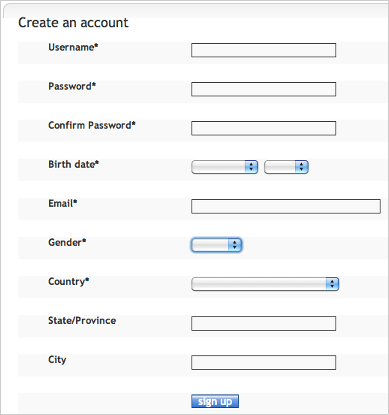Making purchases more difficult for your customers may seem like a crazy idea. But, adding marketing friction can actually increase sales.
Businesses and marketers are constantly warned that friction causes lost sales. They should make it as simple as possible for potential customers to opt-in and make a purchase.
But erecting roadblocks and forcing them to earn it? That contradicts pretty much every marketing manual. Conventional marketing wisdom says that if you cut down on the number of points of friction in your sales funnel, you’ll get more leads and sales.
But you can use friction to your advantage and expand your business.
 What we call “friction” in marketing is anything that stands in the way of a potential customer moving forward through the lead generation process.
What we call “friction” in marketing is anything that stands in the way of a potential customer moving forward through the lead generation process.
Friction can come in many forms, like a complicated checkout process, a slow load time, a confusing website layout, a long wait between an application and a sales call, and so on.
It’s easy to understand that slow page loads would affect your ability to bring in new customers. Design that makes it difficult for customers to act on your messages is equally as bad.
However, there are times when business owners can use certain forms of friction as a means to an end in terms of marketing.
Why Marketing Friction Helps
Imagine that your business just got as many leads in one day as it usually gets in a whole month. The problem is, about half of those leads aren’t interested in buying what you have to offer and won’t turn into paying customers. Sixty percent of the remaining people can’t afford to buy what you’re selling, and another 30% won’t be ready to buy from you for quite some time.
This is the flip side of a lead funnel with no resistance at all. It’s true that you’ll have a larger pool of potential customers to target, but the majority of them won’t be a good fit for your company.
That’s why you need to focus on lead quality ahead of lead quantity. In particular, if you are a service-based or B2B company, if your average deal size is large and your sales cycle is long, or if you rely heavily on outbound sales, friction is highly useful.

If done properly, it can act as a “filter” for your sales pipeline and help your team:
- Screen potential customers at the top of the sales funnel to ensure that your pipeline contains only (or primarily consists of) your ideal target audience.
- Focus your sales team’s efforts on the most promising leads, who are ready to make a purchase immediately.
Be very strategic and calculated about how much and where you place friction in your sales funnel.
The usefulness of friction depends on its being limited, managed, and confined. It should help you learn more about your ideal clients and come across clearly to your leads.
Try these three tried-and-true methods for generating more “good friction” in your campaigns.

1. Test out longer copy even on free offers.
Most business owners have accepted that product and sales pages with lots of information can be very successful.
Write as if you are having a conversation with a potential customer. Ask about their needs and interests, explain how your solution could help them, and answer any questions they might have. It’s often more productive than rushing into a sale, which can backfire.
The same reasoning holds true for your “freebie” website’s landing pages.
You can no longer assume that leads will automatically grab your lead magnet because it’s free. It’s not 2004 anymore, and everyone is completely submerged in “free.” It lost its unique allure a very long time ago.
Explain the benefits of your freebie in as much detail as you would a paid offer. Before you ask leads to convert, describe the situation, promise benefits, and back up your claims with proof.
If you do this, you may notice that (a) more people opt-in, (b) they are much more motivated to implement what you share, and (c) more of them become paying customers down the line!

2. Expand and strengthen your procedure for qualifying leads.
Just how much time does your team spend on leads that aren’t a good fit? You know the type: leads who have unrealistic expectations, can’t afford your services, won’t be ready to buy for a while, etc.
Your sales pipeline could grind to a halt if your team was inundated with too many leads of that quality. To save your team’s time, effort, and sanity, you must eliminate them as soon as possible.
To improve lead qualification and screening, take a look at your current lead-to-sale process flow. If you are a video production company you can ask prospects,
- How soon do you need it?
- What is your project budget?
After getting the answers to these two questions prior to appointments, you can simplify vetting and scoring and see an improvement in the quality of leads. You may see the number of leads drop, but those leads weren’t good anyway.

3. Experiment with "compulsory" lead nurturing and covert offers.
Have you ever realized how some corporations actively discourage customers from purchasing You won’t find any price information on the site other than maybe “starts at $2,000”; or they may make a tempting offer that you have to think twice about, with the caveat that you’ll need to join a waiting list because it’s not available right now.
Don’t these companies want your business? Actually, those businesses are well aware that almost nobody will buy from them right away. Trust needs to be earned. As a result, they direct all new leads to their email list.
There, they can present the offer at the right time, and the lead nurturing process can proceed uninterrupted. For example, it might be presented as a special, one-time offer, which, as you might expect, makes it more likely that someone will buy it.
It’s beneficial to put restrictions on a customer’s purchasing options occasionally. and more specifically, until you know that they can and will buy.

Closing Gets Easier with More Marketing Friction
The best part is that your sales team will have warmer leads that are better qualified. Their probability of closing deals will increase. You have to trust the process and play the long game.
This is where many companies get frustrated: trying to keep up with the nurturing and analytics of their marketing efforts. Fortunately, Pollock Marketing Group is experienced at creating these types of strategies and all the execution tasks it takes to maintain the long game. Contact us today to learn more. (And yes, there will be a qualification form to fill out!)

